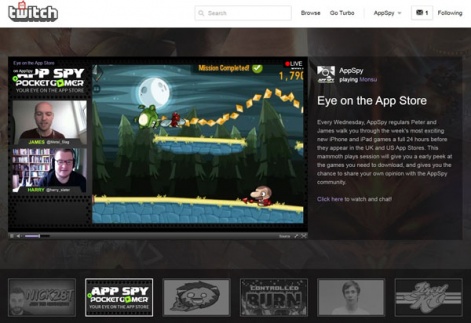Third-party game engines are more pervasive in the games industry than ever.
Unity and Unreal Engine are the big names, but that’s not to forget other players like King’s Defold, Cocos-2dx, GameMaker and CryEngine.
And when Amazon swooped in to purchase CryEngine (Crytek still has its own version of CryEngine) for what would turn into its own Lumberyard engine, a new player entered the field. And this one is backed with one of the world’s biggest firms.
Multiple fronts
A retail giant, Amazon has its fingers in many pies in the games industry at large.
As already mentioned, it has Lumberyard, as well as Amazon Web Services, streaming platform Twitch, the Amazon Appstore (though it’s now ending its Underground programme), its own Fire tablets, and, of course, the general Amazon marketplace itself.
And it has its own Amazon Game Studios too - currently working on PC titles. Officially at least Amazon has yet to announce any plans for mobile games development.
Amazon isn’t messing around when it comes to games. Giving itself a head start with CryEngine, the retail giant has since substantially built on Crytek’s impressive tech to make Lumberyard very much its own game engine.
“From the CryEngine standpoint, that was a great starting point for us,” Amazon Games VP Mike Frazzini tells PocketGamer.biz at GDC 2017.
“Over 50% of the code in Lumberyard is written by Amazon engineers, so it is significantly different at this point. We really wanted to take a lot of the things that were great around the visuals CryEngine is known for and take them further."
To that end, Amazon previewed its DirectX12 renderer during GDC, and Frazzini claims it has now integrated new advanced rendering features that aren’t available in any other engine – at least at the time of the interview.
When it comes to mobile specifically, Amazon has released features for dynamic content updates to make it easier for developers to do on-the-fly updates for their mobile games.
Over 50% of the code in Lumberyard is written by Amazon engineers, so it is significantly different from CryEngine at this point.Mike Frazzini
And Frazzini is also keen to stress it’s been working on helping ensure mobile load times run at around the 10-second mark, with speedy times key for successful mobile titles.
“Fast loads, great graphics and deeply integrated with the cloud. When we talk to developers, they say those are some of the most important things so we focused a lot on those,” says Frazzini.
Increasing prominence
Even with the backing of Amazon, standing out and getting developers to pick your engine over others is no easy task, particularly when rivals are so well established.
Frazzini says one of the ways Amazon is trying to find an edge is to focus on customers. He says when talking to developers about what they struggle with, “there is not a shortage of interesting things to solve”.
“It's not like an industry where everything is all sorted out and the creators are fully functional and at peak optimisation,” he states.
“In fact what we hear from the games companies is they want an engine that is capable of very high performance, that’s productive – which means easy to use – and that's modular and flexible, that allows them to make customisations exactly where they want to be able to make them.
“And so when we think about the base engine of Lumberyard, we want to nail those three things.”
New tech for a new market
One of the biggest draws for Lumberyard perhaps is its integration with the Amazon Web Services cloud – tech that’s already been used by numerous games developers including Supercell, Rovio and King.
Then there’s also the close ties with streaming platform Twitch, which has great potential for marketing and community building.
And it’s these close ties to cloud technology and broadcasting that are defining a new way of building a game engine, according to Frazzini. And one that is fulfilling the needs of what modern developers want from such tech.

“There's a saying a long time ago in boxed product games which was you build your games for the marketing vehicle,” says Frazzini.
“Well the marketing vehicles have evolved over time and today Twitch is an enormous marketing vehicle for games for discovery. What would it mean to build a game for Twitch? So we started to think, how do we make it easier for broadcasters? How do we make it more interesting for viewers? So we have things like, if you have a competitive game, what always works in competitive games from a viewing standpoint are statistics.
“…So within Lumberyard we built something called Metastream which just generates a bunch of data for a broadcaster to consume and present to people watching the game.
“The idea is to build a great engine, deeply connected to the cloud, and then really offer an increasing number of tools to help games reach an audience. That's kind of how we're thinking about it, and there's no game engine that's thinking that broadly about this space.”
Coming together
Building up the Lumberyard community and resources to the level of that of Unreal and Unity is something that is clearly going to take time. Though whether developers will have the patience for this in the meantime is another matter entirely.
The idea is to build a great engine, deeply connected to the cloud, and then offer tools to help games reach an audience.Mike Frazzini
For now though, Amazon is working hard on building up its userbase, building samples, tutorials and actively supporting community members to help others. Frazzini claims that activity on the Lumberyard forums has “exceeded our expectations”, but accepts it’ll take time to reach a broad audience.
“It's just about starting, taking it very seriously, enabling it as much as possible, supporting it, then building over time,” he says.
Building up the engine’s mobile community specifically is another challenge altogether. With its CryEngine roots, the tech is better known for powering high quality graphics on PC.
When put to Frazzini that Lumberyard is not seen as a mobile engine, he offers the rendering features it can provide mobile devs, as well as the fast load times, modularity and ease of use it holds.
“I'd say mobile is a big priority for us,” he says, later adding that it’s working on other key areas such as making the engine better for fast prototyping by improving the first-time user experience, enabling developers to efficiently make content, and then efficiently iterate on that content.
It’s clear that Amazon is continuing to invest big in Lumberyard and its other tech and services in the games space.
Frazzini says it just had the biggest booth it’s ever had at GDC 2017, and it wants to continue improving its tools by paying attention to the current needs of developers.
“We want to be the best listeners on the planet, and we're just getting started,” he concludes.





















